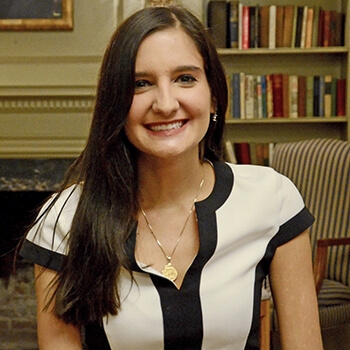Tackling post-recession monetary policy
Laura Nicolae is attempting to determine the future of monetary policy as the economic community continues to deal with the effects of the Great Recession of 2008.
“I’m looking at the effects of the Dodd-Frank Act’s liquidity coverage ratio on large banks’ demands for reserves,” said Nicolae, an applied mathematics concentrator with a focus in economics at the Harvard John A. Paulson School of Engineering and Applied Sciences. “Since the 2008 crisis, banks demand a lot more reserves than they did before the recession, which has really thrown off the planned course of monetary policy.”
The Dodd-Frank Act, or the Dodd-Frank Wall Street Reform and Consumer Protection Act, authored by Senator Christopher J. Dodd (D-Conn.) and U.S. Representative Barney Frank (D-Mass.), was passed into law in 2010. It placed regulations on the financial industry in an effort to prevent another economic collapse. Nicolae is researching the effects of one such regulation, the liquidity coverage ratio (LCR), which requires banks to hold more liquid assets in the form of reserves. Its purpose is to provide banks with a significant cushion of cash in anticipation of future market-wide shocks.
Currently, the Federal Reserve has been struggling to determine what should be done with their balance sheet policy, which was disrupted by the 2008 crisis, Nicolae explained. The issue stems from the Fed buying a significant amount of assets during the recession through quantitative easing, a method of expanding the money supply to encourage lending and investment. With the recession behind us, the Fed is reducing its balance sheet by getting rid of those assets, causing a decrease in the supply of reserves during a time where demand is high, which has put upward pressure on short-term interest rates.
“We saw [this] happening and no one really knew how long the balance sheet reduction could continue happening without producing high or volatile interest rates, and that all depends on the question of how much do banks demand in reserves today,” Nicolae said. “I think it is the most important question in monetary policy today because observers did not expect the fed funds rate, which is the Fed’s key policy rate, to drift above target so soon. When it started drifting about a year ago, some thought that it was a one-off increase, but I suspected that it was actually due to the high demand for reserves and the shrinking supply of reserves.”
The observation that regulations increased banks’ demand for reserves in the aftermath of the recession has largely been confirmed by others in the economic community, but only qualitatively, Nicolae explained. Quantitative estimates are necessary to create effective policies for factors such as interest rates, which require specific target levels. This is where Nicolae is basing her research.
With the help of her thesis advisor, Jeffrey Miron, Director of Graduate and Undergraduate Studies in the Economics Department, and Jeremy Stein, Chair of the Economics Department and Moise Y. Safra Professor of Economics, Nicolae has been combing through data on banks’ holdings of assets to establish quantitative conclusions for the effects of the liquidity coverage ratio on banks’ demand for reserves following the recession.
“In terms of the liquidity coverage ratio regulation, it creates three cutoffs based on the size of the bank. The biggest banks are the most highly regulated,” she said. “The regulation affects the different tiers of banks differently, so you can see what two groups of banks on either side of a cutoff did differently around the time the regulation was adopted. If the banks in two different tiers are sufficiently similar in other respects, you can probably attribute the different trajectories in their reserve holdings to the change in regulation.”
The challenge is that a bank’s preference towards holding more or less reserves is not directly observable; it must be inferred from other factors.
“Ultimately, a preference is in somebody’s head,” said Nicolae. “There are plenty of reasons, plenty of ways in which bank’s preferences may have changed. Maybe their only motivation is the new regulation, complying with the law. Or maybe if we even took away the regulations, large banks would still want to hold more reserves because they are more scared than before. We don’t really know.”
Beyond her research over the summer, Nicolae hopes to branch out during her senior year and take advantage of Harvard’s liberal arts education by delving into her secondary subject, philosophy. Although she knows she will be taking her degree in economics further after graduation, she is still undecided in what form that will take, and hopes that her summer research will point her in the right direction.
